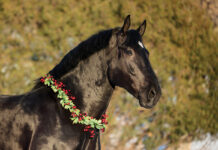Peruvian Horse
The Peruvian Horse developed in Peru primarily during the 17th century, when Spain experienced a shortage of horses and fewer animals were transported to the New World. Horses that were already in Peru became isolated because of the country’s position between the Pacific Ocean and the Andes Mountains, preserving the genetic lineage. The horses that resulted from this period eventually became the foundation stock for today’s Peruvian Horse.
Once the Peruvian Horse was established as a distinct type, breeders in the 1800s and 1900s began breeding for certain characteristics. Wealthy plantation owners bred Peruvian Horses for a smooth ride and the look that is now considered traditional in the breed.
In the late 1960s, the Peruvian Horse was introduced to the United States. Since then, approximately 23,000 purebred Peruvian Horses have been registered in U.S. registries. Some experts believe as many as 10,000 Peruvian Horses can be found in the United States today.
The Peruvian Horse is used in a number of different disciplines. It is often seen as a trail mount, as well as a show, parade and working ranch horse.
The breed is well-known for its easy gaits. Peruvians have two four-beat gaits: the paso llano and sobreandando. Speed is the primary difference between the two gaits. The paso llano is a medium-paced broken gait, meaning there is no lateral or vertical movement in the saddle. A four-beat stepping gait, the paso llano is performed by the rear left foot striking the ground first, followed by the front left foot, the rear right foot and the front right foot. The footfalls are separated by equal amounts of time, resulting in a consistent four-beat rhythm.
The sobreandando has the same footfall, but it’s a faster gait. Both gaits feature termino, an action of the front legs that causes them to swing out as they roll from the shoulder outward, forward and then down. The hooves return squarely to the ground. These gaits are passed down to all purebred foals and don’t need to be trained.
Another characteristic of the Peruvian Horse is brio, which refers to the breed’s natural tendency to work for the rider with alertness and a willing attitude. Peruvian Horses that possess brio are sensitive without being hyper, and have a lot of energy but are easy to handle. For many people, brio is among the most important characteristics of the Peruvian breed.
Because of the Peruvian’s smooth gaits, the breed has become a favorite mount for people who would normally be sidelined from riding due to back issues.
Peruvian Horse Characteristics
Body: The chest is wide, and the back is strong and short to medium in length. A nicely rounded croup leads to a low-set tail.
Head & Neck: The head is medium-sized with a straight or slightly concave profile and a small muzzle. The ears have fine, slightly inwardly curved tips. The neck is gracefully arched at the crest.
Height: 14.1 to 15.1 hands.
Colors: Bay, black, brown, buckskin, chestnut, dun, gray, grullo, palomino and roan.
Liked this article? Here are others you’ll enjoy:
Peruvian Paso Breed Profile
Back to Latin American Horse Breeds >>
This article originally appeared in the July 2011 issue of Horse Illustrated. Click here to subscribe!






started riding after 50 years without horses…discovered Peruvians at a fair in Panama and fell in love…now have 5! at 65/68 respectively my husband who is 100% disabled, and I ride for a couple of hours most days, beach, mountain trails…incredibly comfortable gait, extremely willing, small, easy keepers and lots of fun to have around the house….they are wonderful!
Such a cool breed.